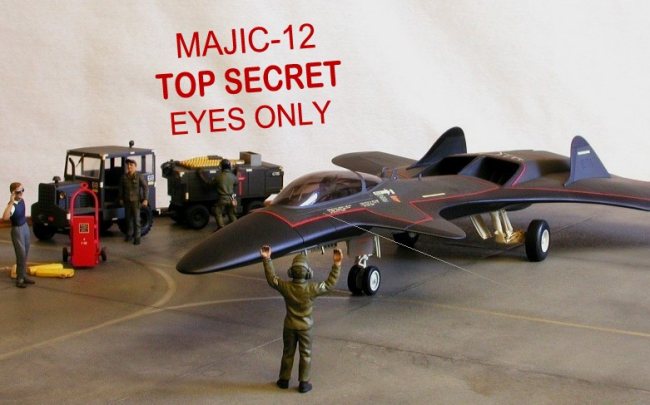
|
KIT: |
Monogram F-19A Stealth Fighter |
|
KIT # |
5824 |
|
PRICE: |
$8.50 (1987) |
|
DECALS: |
One aircraft |
|
REVIEW & |
|
|
NOTES: |
Discontinued |

|
HISTORY |
Dark
Skies
By John Loengard
Alamo, Nevada
These are recently declassified photos of the Northrop (now Northrop-Grumman) R-5D Scepter. First developed more than twenty years ago as a contender for the “Have Lavender” low-observable strike aircraft program with the military designation of F-19A, this revolutionary aircraft nearly fell victim to its own success. The customer’s initial RFP had specified sub-sonic performance and a service ceiling of 48,000 ft. and the R-5D handily bested these specifications by a factor of five.
Engineers at Aerodyne, the manufacturer of the Scepter’s twin hy-scram powerplants, in conjunction with ChemTech Amalgamated, producer of a new ammoidal-hydrazine fuel, created an aeronautical miracle—an aircraft with a hypersonic cruise envelope at near-orbital altitudes with the specific fuel consumption of a T-38. Yet unmatchable by contemporary standards, the USAF was neither pleased nor amused, eventually awarding the contract to Lockheed based on its own “Have Blue” prototype.
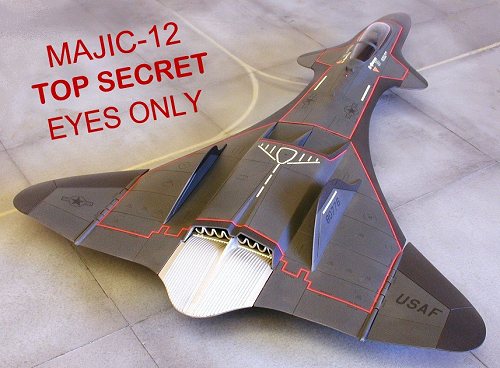 Concurrently, hostile extraterrestrial ‘grays’, infected and co-opted by the
Hive, had made significant incursions and infiltrations into CONUS airspace,
eventually establishing a forward base on Catalina Island, off the southern
California coast. Air Force and Naval units fought a futilely feeble holding
action with conventional assets, as appeasers in Washington, emboldened by their
lackeys in Hollywood and the U.N., clamored for a negotiated settlement.
Concurrently, hostile extraterrestrial ‘grays’, infected and co-opted by the
Hive, had made significant incursions and infiltrations into CONUS airspace,
eventually establishing a forward base on Catalina Island, off the southern
California coast. Air Force and Naval units fought a futilely feeble holding
action with conventional assets, as appeasers in Washington, emboldened by their
lackeys in Hollywood and the U.N., clamored for a negotiated settlement.
Captain Frank Bach (USN), chairman of the Majestic-12 advisory board, discovered and dusted off the plans for this aircraft just as the bureaucratic droids and political pantywaists at the Pentagon sheepishly admitted their lack of a comprehensive or cohesive strategy for dealing with this crisis. With Congress loath to appropriate or authorize funds to build this aircraft, Captain Bach, operating under emergency National Command Authority, secured funding through other less-conventional avenues, specifically a coalition of the John Birch Society, the National Rifle Association, and the Boy Scouts of America.
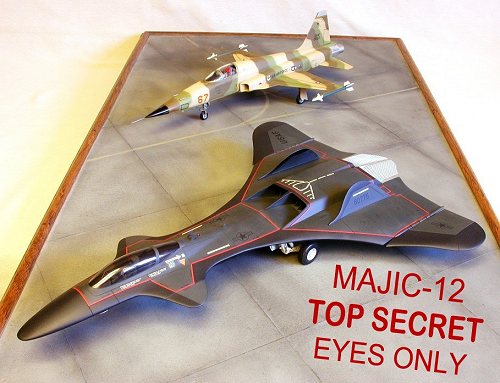 Twenty-eight of these aircraft were built, plus seven pre-production prototypes
eventually upgraded to production standards. Formed into a provisional wing of
three squadrons, the R-5Ds handily bested all three of the grays’ saucer
designs, utilizing an enhanced AIM-120 AMRAAM fitted with a thermonuclear
warhead. With the Hive’s aerial craft rendered combat ineffective, USAF and USN
aircraft attacked and destroyed the base on Catalina Island, with a quick ground
mop-up conducted by the Marine Corps and elements of the Army’s 11th
ACR from Ft. Irwin.
Twenty-eight of these aircraft were built, plus seven pre-production prototypes
eventually upgraded to production standards. Formed into a provisional wing of
three squadrons, the R-5Ds handily bested all three of the grays’ saucer
designs, utilizing an enhanced AIM-120 AMRAAM fitted with a thermonuclear
warhead. With the Hive’s aerial craft rendered combat ineffective, USAF and USN
aircraft attacked and destroyed the base on Catalina Island, with a quick ground
mop-up conducted by the Marine Corps and elements of the Army’s 11th
ACR from Ft. Irwin.
Ironically, following the defeat of the aliens, the entire Scepter fleet was grounded. The Sierra Club, in conspiracy with PETA, Green Peace, and Earth First! secured a restraining order from an environmentally-friendly court against ChemTech Amalgamated while a racketeering and payola scandal sent Aerodyne into receivership, eventually to be purchased by corporate raiders secretly representing the Estes Corporation. Lacking suitable fuel and logistical support, the R-5Ds were placed into MJ-12’s subterranean storage facility at Mercury, Nevada.
For his leadership, Captain Bach received the Defense Meritorious Service Medal from the President in a private rose garden ceremony at the White House. As a further tribute to his foresight and diligence, the daycare center at the Navy’s SeaBee Training Center near Gulfport, Mississippi was renamed in his honor. Upon his retirement he moved to O’Fallon, Illinois and purchased a Popeye’s Chicken franchise.
R-5D Specifications
Length……………………………………………53ft 6in
Wingspan…………………………………………36ft 8in
Height………………………….…………………..8ft 4in
Max T/O Weight……………………………….34,200lbs
Combat Weight………………………………...26,625lbs
Max Speed……………………….………………..Mach 5
Cruising Speed…………………….…………..Mach 2.66
Service Ceiling…………………………………235,000ft
Max Ferry Range…………………………………6400nm
Combat Radius…………………………………...1870nm
Armament………………………....4 x AIM-120-W93-SP
Fire Control System...................... AN/APQ-125C with
cryogenically cooled infra-red and temporal/magnetic search
and track fire control functions.
Engines…2 x Aerodyne HJ-20 with 36,000lbs thrust each
Construction…………Cyano-acrylically bonded graphite/
epoxy fuselage
and wing, titanium
engine
nacelles, Lumispex-coated
canopy, all
sheathed by
classified
proprietary
RAM
Crew……………..1 in D model, 2 in E model (eight built)
|
THE KIT |
 Monogram’s F-19A
Stealth Fighter kit is comprised of thirty-three graphite-colored parts, a
two-piece canopy and a HUD molded in transparent smoke-gray, a fold-out
instruction manual and decals for one aircraft. The pigmented styrene is
similar in hue to the company’s previously released F-20 Tigershark kit,
with microscopic flecks of aluminum dust embedded in the plastic.
Monogram’s F-19A
Stealth Fighter kit is comprised of thirty-three graphite-colored parts, a
two-piece canopy and a HUD molded in transparent smoke-gray, a fold-out
instruction manual and decals for one aircraft. The pigmented styrene is
similar in hue to the company’s previously released F-20 Tigershark kit,
with microscopic flecks of aluminum dust embedded in the plastic.
The seemingly speculative design affords a relatively conventional parts layout with large top and bottom fuselage halves featuring integrally-molded main wing structures, separate fins and outboard wing panels, and undercarriage components borrowed from other existing aircraft. A rotating weapons bay door, a la F-101B Voodoo, mounts a two-piece “stealth missile”.
The cockpit and canopy is similar to an F-16, with a reclined seat of indeterminable type molded to a one-piece tub, side-mounted control stick and throttle, and a separate instrument panel with three MFDs and other details in raised relief. A well executed pilot figure clad in Nomex and an SPH-6A/U is included for optional use, while the canopy may be posed open.
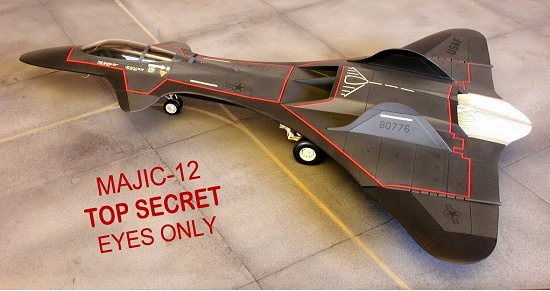 The nose gear
is, in its entirety, souvenired from the F-5/F-20/T-38 aircraft while the main
gear is identical to that of the F/A-18, save for the door configuration. The
ventral rotating weapons bay door is engineered to operate if correctly
assembled and carries the model’s only ordnance, a small conceptualized
rocket-powered projectile.
The nose gear
is, in its entirety, souvenired from the F-5/F-20/T-38 aircraft while the main
gear is identical to that of the F/A-18, save for the door configuration. The
ventral rotating weapons bay door is engineered to operate if correctly
assembled and carries the model’s only ordnance, a small conceptualized
rocket-powered projectile.
The intake diffuser and exhaust ‘platypus tail’ are furnished as inserts to be installed from the inside of the fuselage, thus minimizing joint clean-up. The vertical fins mount via a loosely-fitting tab-and-slot arrangement with caution required to achieve the necessary symmetrical cant. The outer wing panels are likewise an ambiguous fit with lackluster tolerances at the hinge lines.
Like the model itself, the decals are presumably conjecture and offer serial numbers, low-viz national insignia, and service logos. Wing walks, ‘slime lights’ and minimal stenciling are included along with a whimsical ghost figure for the vertical fins. Overall, the sheet reprises Monogram’s prototypical quality: thick and glossy, with excessive adhesive on the paper.
|
CONSTRUCTION |
The alleged fictitious nature of this model relegates shape, proportion, and fidelity of scale discussions to moot status. A project like this invariably becomes a contest between basic modeling skills and one’s own imagination. Ultimately, the mission is to convincingly depict a possible, nigh probable, alternate reality.
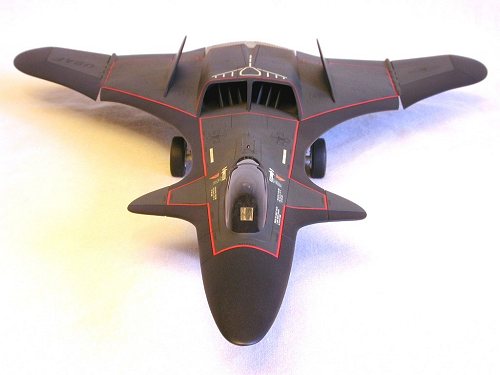 In a rare
departure from convention (for me) I decided to use the pilot figure and portray
the aircraft in a ‘taxi’ configuration. After painting the interior pieces I
glued the pilot to the seat then attached the cockpit tub to the upper
fuselage. A small rectangle of clear acetate replaced the kit’s HUD glass,
affixed with Elmer’s glue. The smoke gray canopy ensured that very little of
the minimally-detailed cockpit would be visible, but nevertheless I painted the
figure in the appropriate Modelmaster shades, using an old pair of flight
coveralls and helmet to match the colors to. With the interior complete, I
attached the canopy using white glue, then moved to the intake diffuser.
In a rare
departure from convention (for me) I decided to use the pilot figure and portray
the aircraft in a ‘taxi’ configuration. After painting the interior pieces I
glued the pilot to the seat then attached the cockpit tub to the upper
fuselage. A small rectangle of clear acetate replaced the kit’s HUD glass,
affixed with Elmer’s glue. The smoke gray canopy ensured that very little of
the minimally-detailed cockpit would be visible, but nevertheless I painted the
figure in the appropriate Modelmaster shades, using an old pair of flight
coveralls and helmet to match the colors to. With the interior complete, I
attached the canopy using white glue, then moved to the intake diffuser.
After pruning away some minor flash I carefully pre-fit the part and glued it with Crazy Glue. The center divider was a little short so repeated fills with CA were needed to bring it into contact with the upper lip of the duct. Following some work with a file and sandpaper the intake assumed the proper contour so I installed the exhaust assembly after some adjustments to the mounting pins.
At this point I deviated from the recommended assembly procedure and attached the two vertical fins. This permitted a cleaner gluing operation as the Crazy Glue was applied from the inside of the wing, thus minimizing joint cleanup. Masking tape was used to hold the fins at the proper angle as the corresponding slots were grossly oversized.
The fuselage was then glued together, using gap-filling Hot Stuff. The fit here was rather poor, with repeated fills necessary for a proper bond. After sanding the seams flush I rescribed the surface detail using Verlinden’s photo-etched template set and a draftsman’s eraser shield as guides. Following a light scuffing with 600-grit 3M automotive film, I set the model aside and tackled the outer wing panels.
As legend would have it, the stealth fighter’s outer wings were hinged and/or removable to allow four of the aircraft to be clandestinely deployed to forward operating locations aboard a C-5 Galaxy. Thusly, this model’s outer wings install with a simulated ‘piano’ hinge. Alternating hinge segments are molded to both the main wing and the outer panels to permit mounting in the folded, taxi, or in-flight positions. Theoretically this seems logical, but realistically it’s a bit of a stretch.
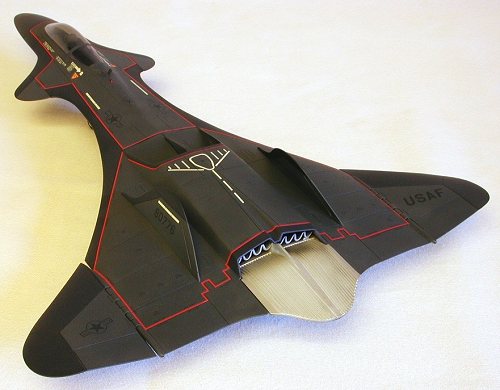 Loose tolerances
created by poor tooling of the molds guarantees weak mounting points regardless
of which wing configuration is selected. I toyed with the idea of line-boring
the hinge segments and installing a pivot pin but dismissed the notion due to
the lack of a sufficiently long drill bit in the appropriate diameter. I also
gave a thought to replacing the hinge segments with aluminum tubing and steel
wire, to allow for an operating hinge.
Loose tolerances
created by poor tooling of the molds guarantees weak mounting points regardless
of which wing configuration is selected. I toyed with the idea of line-boring
the hinge segments and installing a pivot pin but dismissed the notion due to
the lack of a sufficiently long drill bit in the appropriate diameter. I also
gave a thought to replacing the hinge segments with aluminum tubing and steel
wire, to allow for an operating hinge.
Ultimately I took the easy road and installed a pair of brass wire pins in each outer wing panel, to fit into corresponding holes drilled into the ends of the primary wing structure. After bending these ersatz struts to configure the wings in the ‘taxi’ position, Crazy Glue, teased into the hinge segments with a piece of .010” guitar string, was used to seal up the gaps in the hinge line, creating a relatively solid installation.
With the basic airframe complete I opted to indulge in a little creative engineering with the remainder of the construction. Drawing upon my radar background and general knowledge of aerodynamics, I decided to rearrange the weapons bay with a standard hinged double door. My reasons were two-fold: A) Any supersonic aircraft with a rotating structure would doubtless require fixed vortex generators and/or other stabilizing devices to prevent buffeting and maintain the trim of the aircraft when the door was rotated, and B) Said devices would degrade or destroy the low-observable RF characteristics of the airframe (witness the B-2 and F-117 layout).
After assembling the door I scribed a new reveal down the center to simulate a pair of panels and attached it to the fuselage at the pivot points with a couple of drops of CA.. The kit-supplied ‘stealth missile’ was consigned to the FOD container then I moved to the landing gear.
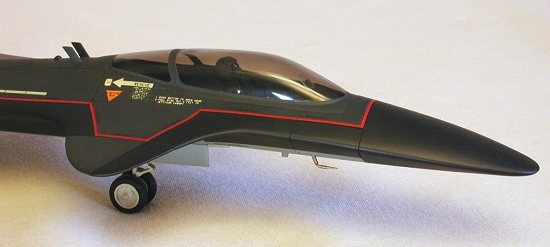 Here I took
several liberties by beefing up the character of the model’s stance. The main
wheels were replaced with spare A-10 units left over from an earlier Warthog
project, while the nose gear got a total revamp. The first thing to get the
boot was the single-wheel F-5 strut, to be replaced by a modified F-100 piece
mounting a pair of standard Monogram A-7 nosewheels.
Here I took
several liberties by beefing up the character of the model’s stance. The main
wheels were replaced with spare A-10 units left over from an earlier Warthog
project, while the nose gear got a total revamp. The first thing to get the
boot was the single-wheel F-5 strut, to be replaced by a modified F-100 piece
mounting a pair of standard Monogram A-7 nosewheels.
Next, I removed the forward portion of the gearwell and substituted a shortened nose well section from Hasegawa’s 1/32nd scale F-104G. After installing and sanding it flush I used parts from the Hasegawa kit’s speedbrake actuator to fashion a retraction jack for the front of the strut. The dual doors covering the enlarged well were taken from the Starfighter kit as well while the smaller rear door is a piece from Monogram’s F-100. After painting and assembling the landing gear components I installed them and moved to the final detail phase.
Using some logical extrapolation I built a set of pitot tubes and an outside air temperature probe and glued them below the nose. Upper and lower IFF/SIF antennas were attached to the fuselage, along with a matched set of TACAN blades behind the canopy. Upper and lower anti-collision beacons were fabricated from transparent red polystyrene while the cockpit ECU and avionics bay vents are photo-etched grills. Further aft I installed a pair of oil drain vents and an APU exhaust below the engine nacelles.
After inspecting the seams I lightly sanded the model again then ordered all personnel not cleared for TS-SCI or above to vacate the paint shop.
|
PAINT & DECALS |
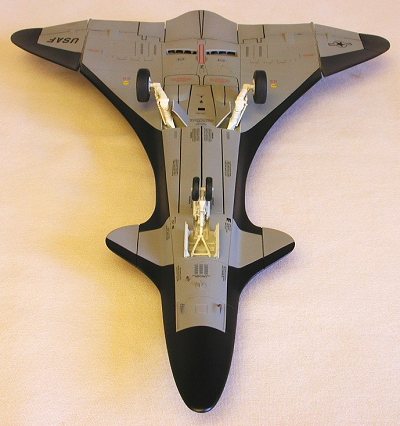 I adhered pretty
much to the suggested painting guide for the dorsal areas, using Euro I Gray (FS
36081), with flat black for the ostensibly RAM-coated radome, ‘chines’, and
leading edge surfaces. Underneath, I wanted some contrast so after much
scientific analysis and careful consideration (ie; what’s the nearest bottle
of light gray on the bench?) I shot Dark Ghost Gray (FS 36320) below. The
corrugated sections of the exhaust platypus were finished with buffable aluminum
Spray ‘n’ Plate.
I adhered pretty
much to the suggested painting guide for the dorsal areas, using Euro I Gray (FS
36081), with flat black for the ostensibly RAM-coated radome, ‘chines’, and
leading edge surfaces. Underneath, I wanted some contrast so after much
scientific analysis and careful consideration (ie; what’s the nearest bottle
of light gray on the bench?) I shot Dark Ghost Gray (FS 36320) below. The
corrugated sections of the exhaust platypus were finished with buffable aluminum
Spray ‘n’ Plate.
After several coats of Testor’s gloss lacquer to level the paint I decaled the model using serial numbers from the Minicraft 1/72nd scale F-106 kit, some generic MicroScale insignia, bits and pieces from the F-111 stencil sheet, and emergency egress warning markings left over from Hasegawa’s F-16A kit. SuperScale solid color decal sliced into thin strips, was applied as wing and fuselage walkways and as aerial refueling alignment guides, while the low-intensity ‘slime lights’ were provided by ScaleMaster.
After sealing the decals with Testor’s Dullcote, Liquitex black watercolor was used as a wash to highlight the movable control surfaces and weapons bay doors. A final light coat of flat lacquer was applied to seal the wash then the masks were removed from the canopy and lights. Time to kick the tires and light the fires…
|
CONCLUSIONS |
After a relatively short availability cycle of only three years this model was discontinued. Released to compete with John Anderson’s equally spurious Testor’s F-19, most modelers found this kit to be a big disappointment, in large measure due to its high price and minimal substance. An assertion with some merit, the box was the same size as that of Monogram’s F-4 Phantom II, a model with real ‘beef’, and the comparatively meager F-19A commanded an identical price.
However, the nature of the subject rendered the premium price an academic afterthought to those true believers who lean to the popular lore of Groom Lake, Area 51, UFOs, the Aurora, extraterrestrial visitors, and the conspiracy theories necessary to support these tenuous positions. The model itself depicts an aircraft reflecting sound aerodynamic engineering and proven design principles so who can rightfully dispute the possibility of the prototype’s existence?
This aircraft was also released as a 1/72nd scale desktop model in Monogram’s Snap-Tite line, with a display stand displacing the undercarriage. Like its 1/48th scale brethren, it was also withdrawn after a short run due to lackluster sales. Both kits may occasionally be encountered at swapmeets, usually at deeply discounted prices. If you believe in Max Brazel, the USS Eldridge, crop circles, the Grassy Knoll, and MAJIC this model may be your tankard of Romulan Ale…
|
REFERENCES |
Classified--I could tell you but then I’d have to kill you…
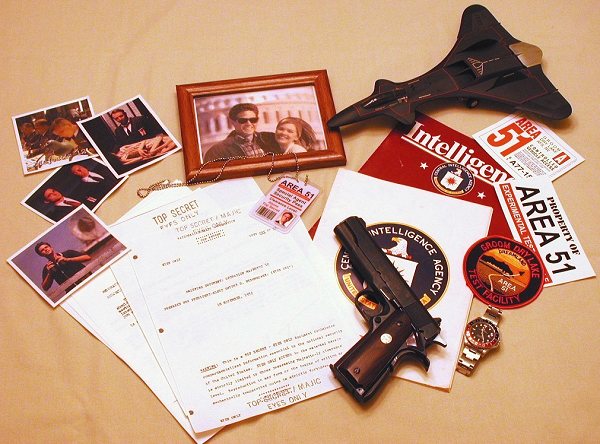
Ó 2002 by Roger M. Jackson
First Time North American Rights To Scott Van Aken and ‘Modeling Madness’
If you would like your product reviewed fairly and quickly by a site that has over 100,000 visitors a month, please contact me or see other details in the Note to Contributors.